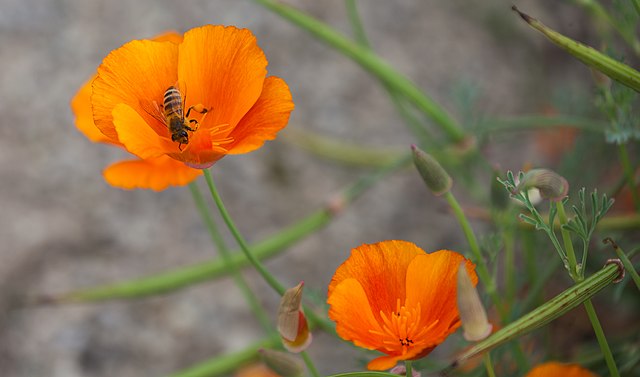Choosing the right plants!
Published 10:23 am Monday, April 14, 2025

- PLANT A POPPY: The California Poppy is a great flower to attract pollinators. As seen here, bees love to visit and get nectar from this rich flower. (Wikimedia Commons)
“The great gift of Easter is hope.” – Basil C. Hume.
“Easter is meant to be a symbol of hope, renewal and new life.” – Janine di Giovanni.
“Easter is very important to me. It’s a second chance.” – Reba McEntire.
Trending
“Easter says you can put Truth in a grave, but it won’t stay there.” – Clarence W. Hall.
“Easter is a time when God turned the inevitability of death into the invincibility of life.” – Craig D. Lounsbrough.
“Easter is the one morning in all of history where the dawn came twice; once on the eastern horizon and again in eternity.” – Craig D. Lounsbrough.
“The resurrection gives my life meaning and direction and the opportunity to start over no matter what my circumstances.” – Robert Flatt.
Scorching summers. Unpredictable rainfall. Water restrictions. Rising temperatures and prolonged droughts challenge gardeners everywhere. A thriving garden is still possible with the right plant choices. Drought-tolerant plants reduce water use, support pollinators, and require less maintenance while keeping your landscape colorful and healthy.
What makes a plant drought-tolerant? Some plants survive in dry conditions much better than others. Drought-tolerant plants are naturally adapted to conserve water and withstand heat. Key traits of drought-tolerant plants include deep roots (can reach moisture deep underground, even when the surface is dry), waxy, silvery, or fleshy leaves (surface reduces water loss and reflects sunlight), and low water needs after establishment (require minimal irrigation once mature). New drought-tolerant plants need regular watering during their first year to establish strong roots. Once established, they will require far less attention.
Trending
Choosing the right plants is the key to creating a lush, resilient, and low-maintenance garden that thrives in dry conditions. Whether you’re looking for colorful perennials, structural shrubs, or edible plants that don’t need much water, these drought-tolerant options will keep your landscape looking beautiful while conserving moisture.
Perennials for a resilient, colorful garden include lavender (Lavandula spp.), Russian sage (Perovskia atriplicifolia), and blanket flower (Gaillardia spp.). Drought-tolerant shrubs and trees used for structure and habitat, as well as woody plants giving year-round appeal and providing shelter for wildlife. Such plants include butterfly bush (Buddleja spp.), crepe myrtle (Lagerstroemia spp.), and Eastern juniper (Juniperus virginiana).
Pollinator-friendly flowers thrive with less water, as well as nectar-rich flowers turning your garden into a haven for pollinators. Such flowers include yarrow (Achillea spp.), California poppy (Echscholzia californica), and salvia (salvia spp.).
Edible plants for a water-wise garden allows the growing of food while conserving water with drought-tolerant, flavorful plants. Such plants include rosemary (Salvia rosemarinus), fig tree (Ficus carica), and prickly pear cactus (Opuntia spp.).
Group plants with similar water needs together to improve efficiency, reduce overwatering, and make irrigation easier. Smart design choices help conserve moisture and reduce the need for irrigation. Using water-wise landscaping techniques can help you create a sustainable garden (even in a dry climate).
Garden design strategies for water conservation include using a mulch to lock in moisture, replacing a portion of the lawn area, choosing permeable hardscaping, and harvesting rain water for dry periods.
Mulch is one of the simplest and most effective ways to conserve water in your garden. A layer of organic mulch (such as composted chipped yard waste, bark chips, straw, or shredded leaves) helps reduce water evaporation, regulate soil temperature, and suppress weeds that might compete with your plants for scarce water. Traditional lawns are one of the biggest water consumers in residential landscapes. Consider replacing areas of your lawn with drought-resistant ground covers, native grasses, or xeriscaped perennial beds.
Also, hardscaping elements like patios, pathways, and driveways can either help or hinder water conservation. Instead of traditional concrete or asphalt, opt for permeable materials that allow rainwater to soak into the soil. Great options include gravel paths (crush or pea gravel), permeable pavers, or stepping stones with ground cover plants. For your areas with concrete or asphalt, consider installing a rainwater capture basin or routing run-off for use by your plants.
And, capturing rainwater is a simple, sustainable way to irrigate your garden sustainably. And your plants will appreciate the chlorine-free water. Good options include installing rain barrels at downspouts, directing roof and pavement runoff into a rain garden or swale, and using buried storage cisterns.
One of the biggest concerns is the belief that drought-resistant gardens are just gravel and cacti, creating a dry and lifeless landscape. While succulents and cacti do thrive in arid conditions, they are far from the only options. A well-designed water-wise garden can be just as lush, colorful, and inviting as any traditional landscape.
Another common concern is the idea that, once established, drought-tolerant plants never need water. While these plants are far more resilient than traditional, water-demanding varieties, they still benefit from occasional deep watering, especially during extreme heat and prolonged dry spells.
Drought-tolerant gardening is a smart, sustainable approach that allows you to conserve water, reduce maintenance, and create a thriving, resilient landscape. By selecting the site-appropriate plants, improving soil health, and using strategic design elements like mulch, permeable hardscaping, and rainwater harvesting, you can enjoy a lush, beautiful garden that requires far less water than a traditional landscape.
If you’re new to drought-tolerant planting, start small! Incorporate just a few water-wise plants into your existing landscape and observe how well they thrive with minimal watering. Over time, you can expand your collection, replace thirsty lawn areas, and create a landscape that is both stunning and sustainable.
“Blessed be the God and Father of our Lord Jesus Christ! According to His great mercy, He has caused us to be born again to a living hope through the resurrection of Jesus Christ from the dead.” 1 Peter 1:3. “For since we believe that Jesus died and rose again, even so, through Jesus, God will bring with Him those who have fallen asleep.” 1 Thessalonians 4:14. “If the Spirit of Him who raised Jesus from the dead dwells in you, He who raised Christ Jesus from the dead will also give life to your mortal bodies through his Spirit who dwells in you.” Romans 8:11. “For this is the will of My Father, that everyone who looks on the Son and believes in Him should have eternal life, and I will raise him up on the last day.” John 6:40.





